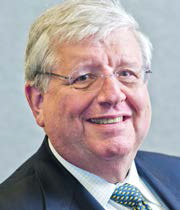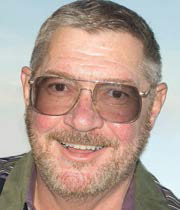2016: A ‘Huuuuge’ Year
It’s that time again… to look back at the past year and forward to a new year. The pace of change is accelerating every year and 2016 saw numerous milestones for the broadcast industry. To help make sense of it all, we asked some of our feature writers to offer their thoughts.
Happy holidays from TV Technology!

CHARLIE RHODES,Digital TV
Perhaps the future of over-the-air terrestrial VT broadcasting will be determined by the outcome of the series of spectrum auctions being conducted by the FCC. To date, the FCC has held 3 of these, starting with 126 MHz of spectrum on the block. It failed. Then a second auction with 114 MHz of our spectrum was held and it too failed. So the FCC conducted a third auction with only 108 MHz available and it too has failed. The next auction with only 84 MHz on the block will start soon. It is beginning to appear that our 600 MHz Band is no longer as desirable as it was when these auctions were planned.

AL KOVALICK,Cloudspotters Journal
The migration to all things IT, Ethernet/IP and cloud continues. SMPTE’s effort to standardize the transport of A/V over IP is making good progress. Many vendors “see the light” and are offering software products that run in the public and private clouds. SaaS is growing at an annual growth rate of 27 percent and the transition to cloud-based apps for the media enterprise is in full swing.
This year marked a turning point for cloud acceptance by media companies. Cloud services are now considered by many as more secure than many enterprise systems. Savvy technical staff are bulking up for the future and learning all they can about this new world that will transform our media infrastructure and culture.

GARY ARLEN,Multiscreen Views
Video carriage on YouTube, Twitter, Facebook, Snap, Instagram and other social media platforms—which expanded broadly in 2016—underscored the massive rearrangement of the video distribution business. Along with MVPD’s skinny bundles and programmers’ moves (HBOGo, Starz streams on DirecTV Now and others) to sell directly to viewers, new audiences are learning to watch video-on-demand as they like it. Add in content marketing and other non-traditional video productions, and the viewing fragmentation is pervasive. Equally important, advertisers are moving budgets to new video platforms.
On the technology front, the assault of virtual and augmented reality was big and will get much larger. Pokémon GO may have been a summer fad, but its implications for future immersive media ventures are very “real.”
In the world of policy and regulatory issues, 2017 is a “yuuuuge” question mark. With all the bluster about net neutrality, spectrum decisions, privacy and cybersecurity plus ATSC 3.0 approval, there is no clear direction yet for how the new administration, Congress, agencies and courts will deal with media/telecom conundrums.
There are just so many alternatives.

JAY ANKENEY,Focus on Editing
It’s been a pivotal year for editing and post production. But how has 2016 affected the evolving role of the “editor?”
Print-trained journalists now edit news packages on iPhones, and there’s a super computer at IBM named Watson cutting promos for feature films.
Meanwhile primetime pro editors are handling projects shot in HDR, although you’ll best see them on streaming sites mostly known for cat videos. OTA broadcasters won’t catch up until the advent of ATSC 3.0 whose charge to inevitability has subtly gained the tag “voluntary” over the past annum.
Meanwhile, virtual reality projects are groping like pre-Griffith pioneers to develop the grammar of VR’s narrative communication.
On the horizon is light field technology which brings the whole production into the edit bay by capturing the entire volumetric visual information of a scene on multiple imaging arrays.
Are today’s editors stars of post or ringmasters of technological transformation?

JAY YEARY,Inside Audio
The many versions of immersive audio seemed to dominate the audio landscape in 2016, with format decisions now made for Next Generation Audio, and as personalized 3D audio has come into its own as the technology that makes VR truly immersive. This year we should expect to see standard workflows emerge as immersive audio production gradually increases.
Audio-over-IP technology adoption continued this past year but it should exhibit a greater presence in broadcast in 2017 as AES67 is embraced by major standards organizations as their audio streaming technology of choice, leading to its inclusion in SMPTE-2110. Most important of all, hopefully 2017 will be the year that OTT and streaming providers finally embrace loudness management for the content they deliver.

DOUG LUNG,RF Technology
For 2016 the biggest development for broadcasters was the near completion of the ATSC 3.0 standard and it is complicated! Also significant for this past year was the time and effort manufacturers and broadcasters are putting into developing new products for the repack. Many questions remain on what stations will be left, and what the FCC will pay for.
Will broadcasters embrace ATSC 3.0 in 2017? Perhaps it’s too soon to tell, but equipment choices and announcements post NAB could provide some clues.
What’s the future of broadcast TV if they don’t? The impact of the repack? How can the limited number of RF and structural engineers meet the tight CP filing deadlines after the auction closes? As groups scramble to move stations to new channels, will other projects suffer?
After all of this preparation, what happens if the auction fails?
Get the TV Tech Newsletter
The professional video industry's #1 source for news, trends and product and tech information. Sign up below.
Tom has covered the broadcast technology market for the past 25 years, including three years handling member communications for the National Association of Broadcasters followed by a year as editor of Video Technology News and DTV Business executive newsletters for Phillips Publishing. In 1999 he launched digitalbroadcasting.com for internet B2B portal Verticalnet. He is also a charter member of the CTA's Academy of Digital TV Pioneers. Since 2001, he has been editor-in-chief of TV Tech (www.tvtech.com), the leading source of news and information on broadcast and related media technology and is a frequent contributor and moderator to the brand’s Tech Leadership events.

